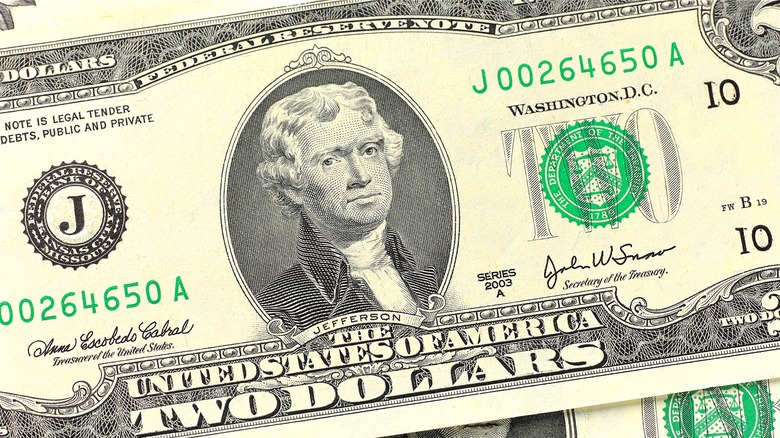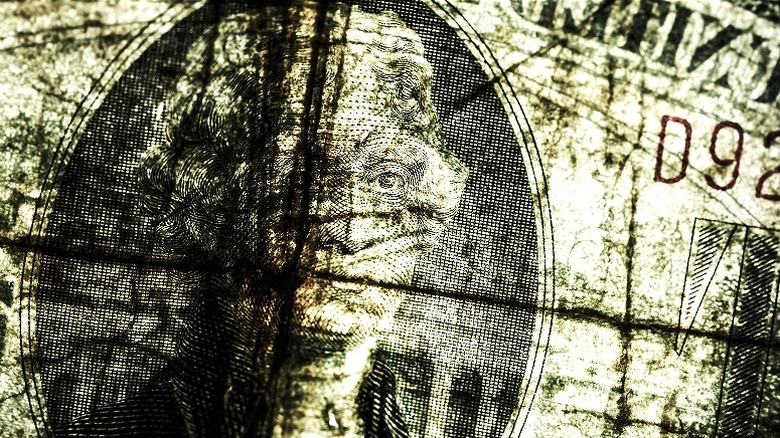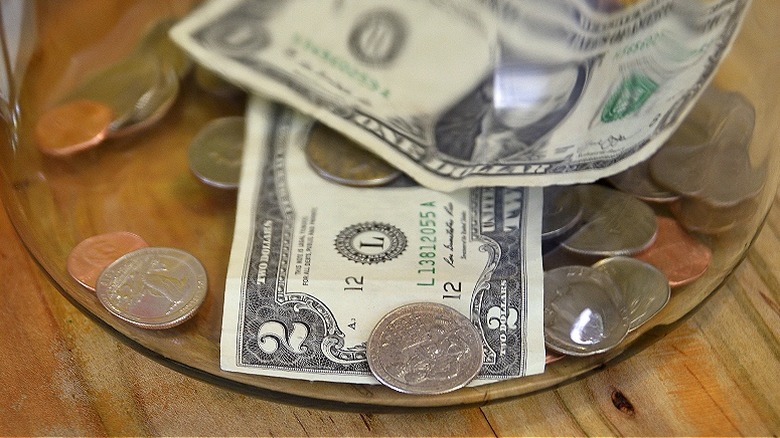The $2 Bill That's Actually Worth A Ton Of Money
The debate over whether the U.S. should bother continuing to produce the penny (as the coin costs more to make than it's worth) is an ongoing one, popping up here and there in news cycles. A similar argument contests the need for the dollar bill; the Government Accountability Office has gone back and forth on whether it would be better to follow peer nations in retiring paper dollars in favor of coins. And then there's the $2 bill, a subject not so much of controversy as scorn and dismissal.
In a catch-22 situation, people don't use $2 bills because they think they're rare or invalid, and the Department of Treasury doesn't make as many of them as other bills because people don't use them. That said, use of the $2 bill was so limited in the 1960s that the currency was briefly retired. And it had its own share of controversies in the 19th and early 20th centuries; the bills were seen as bad luck, or as the denomination of choice for crooks and political corruption.
Superstitions aside, though, there's no good reason not to use your $2 bills. In fact, there are even active campaigns to get the $2 bill into wider circulation. But check the age of your "Tom" (as they're colloquially known because Thomas Jefferson is featured on the obverse), before you spend them. Per U.S. Currency Auctions, an uncirculated $2 bill from a given year could be worth anywhere between $1,000 to $4,500.
The most valuable $2 bills are old and uncirculated
The high values given to $2 bills by U.S. Currency Auctions all applied to uncirculated currency — that is, printed legal tender that was never used in financial transactions. The values were arrived at by averaging the prices bills have fetched at past auctions, and there wasn't necessarily a logical pattern to the value.
For example, you might assume the oldest $2 bills from 1862 (those that couldn't be called "Tom" because they had Alexander Hamilton's portrait on them, per the Bureau of Engraving & Printing) — would be worth more. But U.S. Currency Auctions gave an uncirculated 1862 $2 bill a value of $2,800. The highest value of $4,500, meanwhile, was given to uncirculated 1890 Toms, while the lowest that still crossed the four-figure threshold ($1,000) was given to the 1918 and 1928B bill.
Besides the usual collector's criteria of age, condition, scarcity, and sentimental value, currency collectors look at where and how a bill was printed and what its serial number is. That can sometimes result in relatively recent currency going for a pretty penny. In November 2023, Heritage Auctions sold a 2003 $2 bill for $2,400, only for it to quickly resell for $4,000.
Speaking to WFAA, Raiden Honaker, Heritage Auctions' U.S. currency consignment director, said the auction "blew up across the country," with many people taking a closer look at the $2 bill. "It was cool to see the interest in numismatics," he said. "People started digging out those $2 bills to see if they hit the jackpot."
Most $2 bills aren't worth more than their stated value
With this said, a few high-figure auctions and sales shouldn't blind you to the realities of a $2 bill's value. According to the Federal Reserve, there is $3.2 billion worth of $2 bills in circulation (as of 2023). That means billions of bills, so while the "Tom" is rare in relation to other denominations of U.S. currency, and represents a tiny fraction of the total worth of circulating cash, it's also not exactly scarce. And unless the right set of specific factors break your way, the odds are that any $2 bills you have aren't going to be worth more than the number printed on them.
But the impression of scarcity and novelty surrounding Toms is such that many people won't spend those that fall into their hands. Back in 2015, the Santa Barbara-based Pacific Standard published a story on the "mystery of $2 bills," and noted that some local merchants paid with $2 bills would take them home as keepsakes rather than circulate them (of course, cash registers don't come with a slot for the rarely used denomination). Also, $2 bills took on a more covert value in Michigan in 2013; using $2 bills was seen as a signal of support for marijuana legalization, per USA Today.


